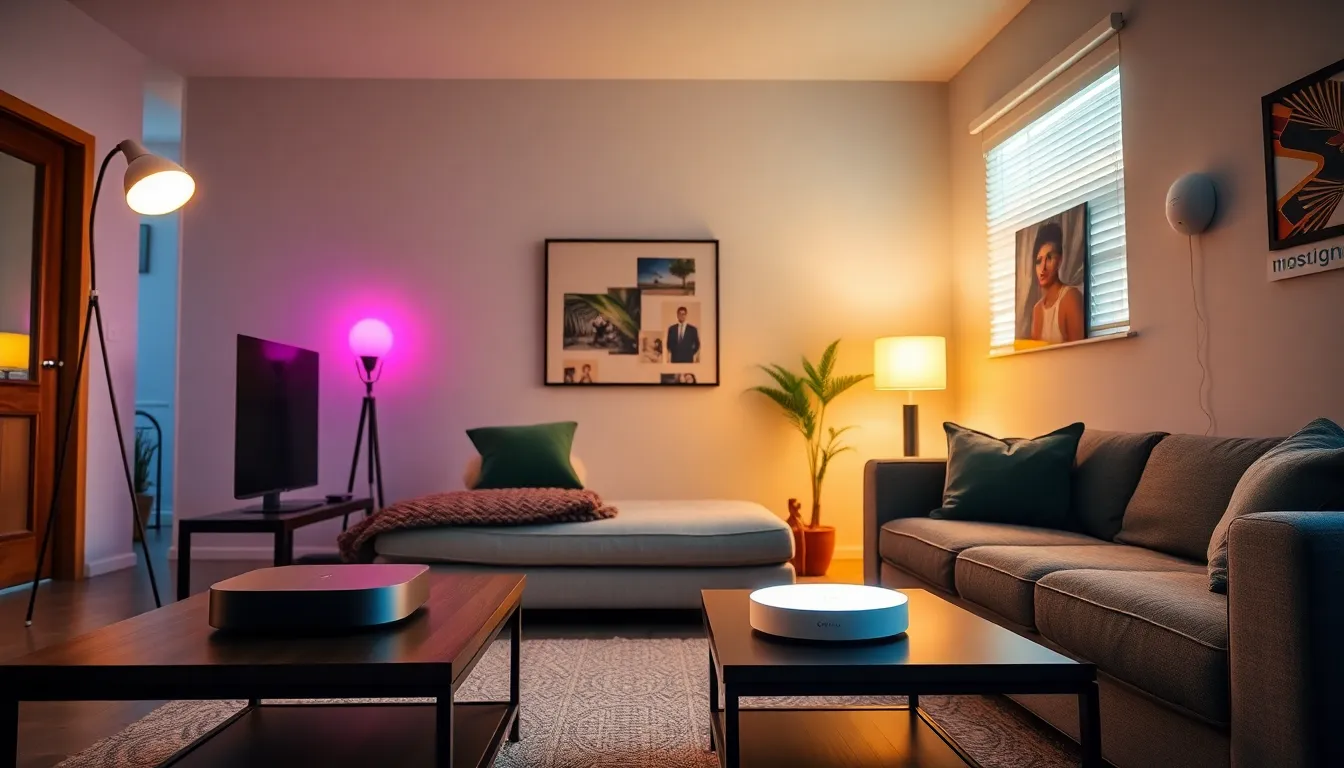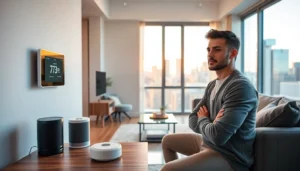Table of Contents
ToggleImagine walking into your home and having the lights flick on, the coffee brewing, and your favorite playlist serenading you—all without lifting a finger. Sounds like magic, right? Welcome to the world of DIY home automation, where you can transform your humble abode into a smart sanctuary.
Gone are the days of fumbling for light switches or worrying about whether you left the thermostat on. With a little creativity and a dash of tech-savvy, anyone can turn their home into a futuristic haven. Plus, who wouldn’t want to impress friends with tales of how they programmed their own smart home? Dive into the exciting realm of DIY home automation, and discover how to make your home smarter, more efficient, and a lot more fun—all while keeping your wallet happy.
Understanding DIY Home Automation
DIY home automation refers to the practice of enhancing a residence’s functionality through technology and personal creativity. This process empowers homeowners to control and automate various systems and devices.
What is DIY Home Automation?
DIY home automation involves integrating smart technology into everyday tasks. Homeowners install devices like smart lights, thermostats, and security cameras to enhance convenience. Each system operates through a central hub or app. Intelligent setups offer customization tailored to individual preferences. Control often extends to lighting schedules, climate adjustments, or security monitoring. Innovative solutions enhance the overall living experience.
Benefits of DIY Home Automation
DIY home automation provides numerous advantages that improve daily life. Increased convenience ranks high, as users can manage devices remotely. Energy savings also contribute to reduced utility bills. Automation often allows for efficient energy use by adjusting settings based on occupancy. Enhanced security remains a vital aspect, with smart cameras and alarms delivering real-time alerts. Customizable experiences serve specific needs, making homes adaptable and enjoyable. Overall, enhancing one’s living space through automation fosters a more modern lifestyle.
Essential Components for DIY Projects

DIY home automation requires specific components to create an efficient and functional smart home setup. Understanding these essential parts allows for seamless integration of technology into daily life.
Smart Hubs and Controllers
Smart hubs connect various devices, acting as a central command for home automation. Popular options include Amazon Echo and Google Nest Hub. These devices facilitate communication between smart gadgets, simplifying control through a single interface. Installation usually involves connecting the hub to Wi-Fi and downloading the corresponding app. Users can automate routines, such as adjusting thermostat settings or scheduling lights, enhancing the overall smart home experience.
Sensors and Switches
Sensors play a crucial role in monitoring changes in the home environment. Motion detectors, temperature sensors, and door/window sensors enhance security and energy efficiency. Switches allow direct control over lights and appliances, adding convenience to the automation process. Wireless models enable easy installation without the need for extensive rewiring. Integrating these sensors and switches provides a responsive home that adapts to individual needs and habits.
Smart Lighting Solutions
Smart lighting offers flexibility and customization for any living space. Options include smart bulbs, strips, and controllers that allow users to adjust brightness and color. Installation often involves replacing existing bulbs with smart versions and connecting them to the home network. Automating lighting increases energy efficiency and enhances mood or ambiance through precise control. Lighting schedules and remote access through apps create an improved living environment, showcasing the full potential of DIY home automation.
Popular DIY Home Automation Projects
DIY home automation projects provide several opportunities to enhance convenience and efficiency in modern living spaces. Here are some top projects to consider.
Smart Lighting Installation
Smart lighting installation offers flexibility and energy efficiency. Install smart bulbs to control light brightness and color through an app. Programmable schedules allow lights to turn on or off automatically, creating a welcoming atmosphere. Integrating motion sensors enhances security by lighting pathways when movement is detected. Controlling lighting via voice commands with devices like Amazon Echo or Google Home simplifies daily routines.
Home Security Systems
Home security systems enhance safety within a home. DIY options include installing smart cameras that provide real-time video feeds accessible via smartphones. Implementing doorbell cameras enables easy visitor monitoring, and indoor security cameras help track activity in key areas. Smart locks allow users to control access without traditional keys. Alerts from security sensors notify homeowners of unusual activity, ensuring prompt response.
Automated Thermostat Setup
Automated thermostat setup allows efficient temperature management. Smart thermostats can learn user preferences and adjust heating or cooling accordingly.
Homeowners can control temperature settings remotely, optimizing energy use while maintaining comfort. Scheduling options also enable automatic adjustment based on daily routines, contributing to significant energy savings. Additionally, integrating sensors that detect occupancy ensures climate control only when needed, enhancing efficiency further.
Best Practices for DIY Home Automation
Effective DIY home automation relies on careful planning and security measures. Implementing these best practices enhances the overall functionality and safety of the smart home experience.
Planning Your System
Successful automation projects begin with clear planning. Identify devices to integrate, such as smart lights and thermostats, determine compatibility requirements, and outline user preferences. Assess the layout of the home, specifying which rooms and areas need automation. Establishing a centralized control system simplifies device management, providing an intuitive user experience. Documenting the automation goals ensures clarity during the installation process. Prioritize tasks based on urgency, such as lighting for safety or security features for peace of mind.
Ensuring Network Security
Securing the home network becomes paramount in DIY automation. Strong passwords for Wi-Fi and device access prevent unauthorized entry. Setting up a dedicated network for smart devices minimizes risks associated with connecting them to personal data. Enabling two-factor authentication adds another layer of protection, securing accounts from potential breaches. Regular updates to device firmware enhance security, addressing vulnerabilities over time. Monitoring network traffic helps identify any suspicious activity, ensuring ongoing safety and reliability.
Embracing DIY home automation opens up a world of possibilities for homeowners looking to enhance their living spaces. With the right tools and a bit of creativity it’s possible to create a smart home that caters to individual needs while improving convenience and efficiency.
By integrating smart technology into daily routines, individuals can enjoy increased comfort and energy savings. Following best practices ensures a secure and reliable setup allowing for a seamless smart home experience.
As technology continues to evolve the potential for innovation in home automation will only grow. Now’s the time to take the leap and transform any home into a modern sanctuary.






